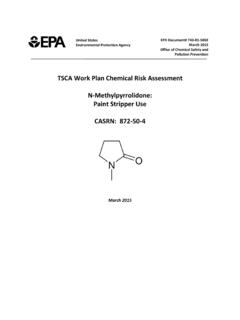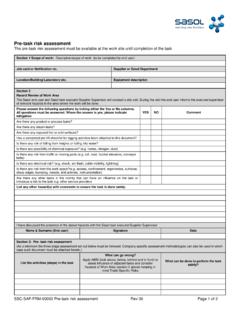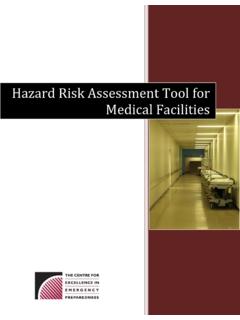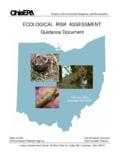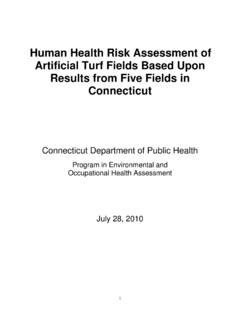Transcription of TSCA Work Plan for Chemical Assessments 2014 Update
1 Environmental Protection Agency October 2014 TSCA work plan for Chemical Assessments : 2014 Update Environmental Protection Agency Office of Pollution Prevention and Toxics October 2014 Environmental Protection Agency October 2014 TSCA work plan for Chemical Assessments : 2014 Update 2 I. Overview EPA is updating its list of existing chemicals for assessment under the Toxic Substances Control Act (TSCA); this is known as the TSCA work plan for Chemical Assessments . The changes to the TSCA work plan for Chemical Assessments reflect updated industry data submitted to EPA through the Toxics Release Inventory (TRI) in 2011 and the TSCA Chemical Data Reporting (CDR) requirements in 2012 on Chemical releases and potential exposures.
2 This is the first Update to the TSCA work plan for Chemical Assessments , which EPA presented in early 2012. As newer data from TRI and CDR become available, EPA will Update the TSCA work plan for Chemical Assessments . The Agency uses this work plan to focus the activities of the Existing Chemicals Program in the Office of Pollution Prevention and Toxics (OPPT) so that existing chemicals having the highest potential for exposure and hazard are assessed, and, if warranted, are subject to risk reduction actions. EPA notes that identification of a Chemical on the TSCA work plan for Chemical Assessments does not itself constitute a finding by the Agency that the Chemical presents a risk to human health or the environment.
3 Rather, identification of a Chemical on the TSCA work plan for Chemical Assessments indicates only that the Agency intends to consider it for assessment . The Agency believes that identifying these chemicals early in the review process would afford all interested parties the opportunity to bring additional relevant information on those chemicals to the Agency s attention to further inform the assessment . Identification of chemicals for the TSCA work plan for Chemical Assessments does not mean EPA would not consider other chemicals for assessment and potential risk reduction action under TSCA and other statutes; for example, if a potential risk has been identified with a Chemical or type of chemicals, EPA may consider these chemicals.
4 EPA will consider other chemicals if warranted by available information. II. Background The 2012 TSCA work plan for Chemical Assessments identified 83 chemicals for assessment by EPA as part of its Chemical safety program. The screening process for identifying these chemicals is based on a combination of hazard, exposure (including via uses), and persistence and bioaccumulation characteristics, and is described in the TSCA work plan Chemicals Methods Document. The Agency continues to use this process, which focuses on chemicals that meet one or more of the following factors: Potential concern for children s health (for example, because of reproductive or developmental effects) Neurotoxic effects Persistent, bioaccumulative and toxic Probable or known carcinogens Used in children s products or in products to which children may be highly exposed Detected in biomonitoring programs.
5 EPA also considered other factors in determining whether a Chemical should be included on the TSCA work plan for Chemical Assessments . Some chemicals identified as high through this scoring system may not necessarily be practical candidates for assessment under TSCA when other information Environmental Protection Agency October 2014 TSCA work plan for Chemical Assessments : 2014 Update 3 is factored into the process. For example, the particular risks presented by certain chemicals may already be addressed by significant regulation under other statutes. III. 2014 Update to the TSCA work plan for Chemical Assessments EPA updated the TSCA work plan for Chemical Assessments by using more recent information submitted in 2012 under the Chemical Data Reporting Rule (CDR) and data reported in 2011 to the Toxics Release Inventory (TRI).
6 These data were used to Update the exposure ranking for the 345 existing chemicals that were generated under the two-step screening process used in the 2012 TSCA work plan for Chemical Assessments . In 2012, the Agency used several sources to identify chemicals meeting prioritization factor criteria as potential candidates for review; a total of 1,235 chemicals were identified. This group was screened to determine if any chemicals should be excluded because they are not subject to TSCA or there was already significant regulation under TSCA, or due to radioactivity, complex process streams, natural occurrence, or other properties. After these chemicals were excluded, 345 chemicals remained as potential candidates and entered the second stage of the work plan screening, which scored them under three characteristics: hazard, exposure, and potential for persistence and bioaccumulation.
7 Details of how chemicals were screened and criteria were used are in the TSCA work plan Chemicals: Methods Document. In addition to re-screening the 345 chemicals identified in 2012, EPA used the methodology developed for the TSCA work plan for Chemical Assessments to screen the Action plan chemicals, which were not part of the 2012 TSCA work plan for Chemical Assessments , as well as two Chemical flame retardants identified during EPA s development of a flame retardant strategy. Based on this assessment , EPA is removing 15 of the original chemicals in the TSCA work plan for Chemical Assessments , consolidating one Chemical , and adding 23 chemicals to the 2014 Update to the TSCA work plan for Chemical Assessments , including five Action plan chemicals or groups.
8 The TSCA work plan for Chemical Assessments : 2014 Update contains 90 chemicals. Completed Chemical Assessments EPA has completed Assessments for four chemicals that are on the TSCA work plan for Chemical Assessments : Trichloroethylene (TCE): This risk assessment addresses trichloroethylene (TCE) as a degreaser, a spot-cleaner in dry cleaning and a spray-on protective coating. On June 25, 2014, EPA released the final risk assessment that identified health risks to consumers using spray aerosol degreasers and spray fixatives and to workers when TCE is used as a degreaser in small commercial shops and as a stain removing agent in dry cleaning. Methylene Chloride or Dichloromethane (DCM): This risk assessment addresses methylene chloride in paint stripper products.
9 On August 28, 2014, EPA released the final risk assessment that indicates health risks to both workers and consumers who use these products, and to bystanders in workplaces and residences where methylene chloride is used. Environmental Protection Agency October 2014 TSCA work plan for Chemical Assessments : 2014 Update 4 1,3,4,6,7,8-Hexahydro-4,6,6,7,8,8,-hexam ethylcyclopenta[ ]-2-benzopyran (HHCB): This risk assessment addresses ecological risks from HHCB as a fragrance ingredient in commercial and consumer products. On August 28, 2014, EPA released the final risk assessment that indicated no concern for this use of HHCB. Antimony Trioxide (ATO): This risk assessment addresses effects on ecological receptors from the use of antimony trioxide (ATO) as a synergist in halogenated flame retardants.
10 On August 28, 2014, EPA released the final risk assessment that indicated no concern for this use of ATO. a. Chemicals Added i. Action plan Chemicals From 2009 to 2011, EPA published ten Chemical Action Plans. Five chemicals or groups of chemicals that scored high under the methodology developed for the TSCA work plan for Chemical Assessments methodology for which EPA has Action Plans are now included in the TSCA work plan for assessment . EPA added the following Action plan chemicals to the TSCA work plan for Chemical Assessments : Bisphenol A (BPA) Decabromodiphenyl ether (decaBDE) Hexabromocyclododecane (HBCD) Nonylphenols and nonylphenol ethoxylates (NP/NPE) Group of phthalates (dibutyl phthalate (DBP), butyl benzyl phthalate (BBP), di-(2-ethylhexyl) phthalate (DEHP), di-n-octyl phthalate (DnOP), di-isononyl phthalate (DINP), di-isodecyl phthalate (DIDP), and di-isobutyl phthalate (DIBP) Though a July 2014 report provided to the Consumer Product Safety Commission (CPSC) by the Chronic Hazard Advisory Panel (CHAP))










